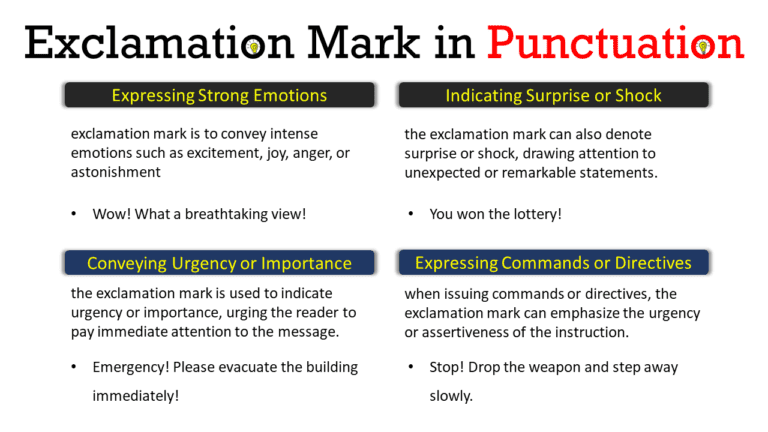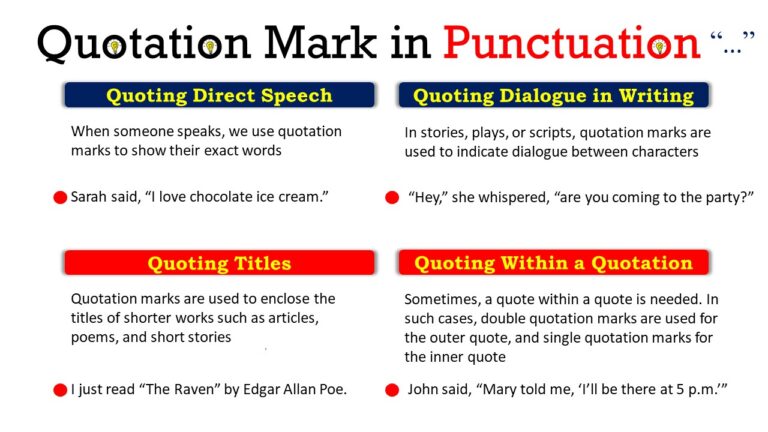In this blog post, you will learn about the question mark, a vital part of English punctuation. The question mark indicates that a sentence is a question, helping to express curiosity and encourage further understanding. Mastering its use will enhance your writing and communication skills. Explore the rules and examples to see how this punctuation mark can improve your grammar.
What is a Question Mark?
A question mark is a punctuation mark (?) used to indicate that a sentence is a question or to express doubt or uncertainty. Direct questions often (but not always) begin with a wh-word (who, what, when, where, why).
Here are five example sentences demonstrating the use of question marks:
- What time is the movie starting?
- Are you going to the party tonight?
- Did you finish your homework yet?
- Why did the chicken cross the road?
- Can you pass me the salt, please?
Read more about: WH-Question Words
Uses and Functions of Question Mark
1۔ Direct Questions
The most common and straightforward use of the question mark is to punctuate direct questions. It signals to the reader that an inquiry is being made, prompting a response.
Examples include:
- What’s your favorite color?
- Where did you go on vacation?
- How old are you?
2۔ Indirect Questions
Sometimes, questions are embedded within a statement without being explicitly stated. In such cases, a question mark isn’t necessary.
Examples:
- She wondered whether he would attend the party.
- He asked what time the movie started.
3۔ Rhetorical Questions
These questions are asked not to elicit a response but to make a point or emphasize a statement. They often imply that the answer is obvious or self-evident.
Examples:
- Do you think I was born yesterday?
- Can you believe this weather?
- Who wouldn’t want to win the lottery?
4۔ In Titles and Headlines
Titles of articles, books, or speeches that pose a question often feature a question mark. It serves to intrigue and engage the audience.
Examples:
- Are We Living in a Simulation?
- What’s Next for Climate Change?
- How Can You Improve Your Writing Skills?
5۔ Uncertainty or Doubt
Question marks can also convey uncertainty or doubt in a statement. They indicate a degree of skepticism or a lack of confidence.
Examples:
- I think we’re lost?
- She might be coming to the party tonight?
When to Avoid Using the Question Mark
1۔ Statements with Intonation
Be cautious of statements that mimic the intonation of a question but aren’t actually seeking an answer. Ending such statements with a question mark can be misleading.
Examples:
- You’re not serious?
- We’re still on for dinner tonight?
2۔ Exclamatory Questions
In sentences that combine both a question and an exclamation, choose one punctuation mark based on the overall tone of the sentence۔
Examples:
- Why did you do that!
- What an amazing performance!
- Learn more about: Exclamation Mark in English
3۔ Imperatives or Commands
Imperatives, which give instructions or commands, should not be followed by a question mark unless there’s a genuine question within the imperative.
Examples:
- Please send me the report by tomorrow.
- Don’t forget to lock the door.
- Learn more about: Imperative Sentences in English
4۔ Indirect Speech
In reported or indirect speech, where a question is reported rather than quoted directly, a question mark isn’t necessary.
Examples:
- She asked where I was going.
- He wondered if it would rain tomorrow.
- Learn more about: Direct & Indirect Speech
5۔ Incomplete or Fragmented Questions
Fragments that imply a question but lack a complete subject or verb shouldn’t be followed by a question mark.
Examples:
- Out of coffee again?
- Meeting at three?
Common Mistakes with Question Mark
Common mistakes with question marks can occur due to confusion about when to use them or where to place them within a sentence. Here are some common errors:
1. Failure to use a question mark at the end of a direct question
This is perhaps the most basic rule. A question mark should always be placed at the end of a direct question.
For example:
- what time is it?
2. Using a question mark with indirect questions
Indirect questions, which are more like statements than direct questions, do not require a question mark.
For example:
- she asked if I wanted coffee.
3. Using a question mark with statements that include question words (who, what, where, when, why, how)
Sometimes, these words are used in statements for emphasis or rhetorical effect, but they don’t actually form questions.
For example:
- I wonder what he’s doing. In this case, “what” is not forming a direct question.
4. Overuse of question marks for emphasis
Using multiple question marks in a row or excessively using them can make writing look unprofessional or unclear.
For example:
- Are you serious???!!! It’s best to use a single question mark when necessary.
5. Incorrect placement with quotation marks
In American English, the question mark should be placed inside the quotation marks if it applies to the quoted material. In British English, it is often placed outside unless it’s part of the quoted material.
For example:
- American: She asked, “How are you feeling?”
- British: She asked, “How are you feeling?”
6. Using a question mark with incomplete questions or sentence fragments
Ensure that the sentence is a complete question before using a question mark.
For example:
- What about? is incomplete and shouldn’t have a question mark. It should be, What about it? or What about that?
7. Using a question mark with imperative sentences
Imperative sentences are commands or requests, not questions.
For example:
- Please pass the salt. This should not have a question mark at the end.
Question marks and Quotation Marks
When your sentence is a simple question, the question mark is placed at the end, serving as the final punctuation mark. However, complexities arise when other punctuation marks are in close proximity.
| Sentence | Correct/Incorrect | Explanation |
|---|---|---|
| “What time is it?” | Correct | A question mark is placed inside the quotation marks. |
| “Where are you going?” | Correct | A question mark is placed inside the quotation marks. |
| “How do you spell ‘necessary’?” | Correct | A question mark is placed inside the quotation marks. |
| She asked, “When will you be home”? | Incorrect | The question mark should be inside the quotation marks. |
| He inquired, “Do you need any help?” | Incorrect | The question mark should be inside the quotation marks. |
| Did he really say, “I love you?” | Incorrect | The question mark should be inside the quotation marks. |
| “May I have a cookie,” she asked. | Incorrect | The comma should be placed inside the quotation marks. |
In these examples, the correct usage demonstrates the question mark placed inside the quotation marks when it is part of the quoted material. The incorrect examples show instances where the question mark is incorrectly placed outside the quotation marks.
Read more about: Quotation marks
Question Marks and Parentheses
| Sentence | Correct/Incorrect | Explanation |
|---|---|---|
| “What time is the meeting?” | Correct | Question mark inside the quotation marks. |
| (What time is the meeting?) | Correct | Parentheses used for clarification or as part of the sentence. |
| “Do you know where she lives?” | Correct | Question mark inside the quotation marks. |
| (Do you know where she lives?) | Correct | Parentheses used for clarification or as part of the sentence. |
| “How are you feeling today?” | Correct | Question mark inside the quotation marks. |
| (How are you feeling today?) | Correct | Parentheses used for clarification or as part of the sentence. |
| She asked, “Are you coming to the party?” | Correct | Question mark inside the quotation marks. |
| She asked, (Are you coming to the party?) | Incorrect | Parentheses should not be used in this context. |
| “What’s your favorite color?” (She asked me.) | Incorrect | The question mark should be inside the quotation marks. |
| (What’s your favorite color?) She asked me. | Incorrect | The question mark should not be outside the parentheses. |
In these examples, the right way to use punctuation follows the usual rules: question marks go inside quotation marks when they’re part of the quoted text, and parentheses are used for explanations or as part of the sentence. Incorrect usage happens when parentheses are wrongly used instead of quotation marks or when question marks are placed outside the parentheses.
Question Mark in Punctuation Infographics
Read More
- Full Stop in Punctuation
- Commas in Punctuation
- Colon in Punctuation
- Semicolon in Punctuation
- Exclamation Mark in Punctuation









